Why Citrus Orange is Effective at Adhesive Removal

When it comes to removing stubborn adhesive residue, few natural solutions are as effective as citrus orange. From peeling off price tags to removing years-old sticker residue, orange-based solvents consistently outperform many commercial adhesive removers while remaining safe for most surfaces and the environment. Understanding the science behind this remarkable cleaning power reveals why citrus orange has become a go-to solution for both household and industrial adhesive removal needs.
The Science Behind Orange’s Adhesive-Busting Power
The secret to orange’s adhesive removal effectiveness lies in a powerful compound called d-limonene, which makes up approximately 90% of orange peel oil. This naturally occurring terpene is extracted from the outer skin of oranges through a process called cold pressing, where the oil-rich cells in the peel are mechanically broken to release their contents.

D-limonene is classified as a monoterpene hydrocarbon with the molecular formula C₁₀H₁₆. Its unique molecular structure gives it remarkable solvent properties that make it particularly effective against petroleum-based adhesives, rubber cements, and synthetic sticky residues. The compound works by penetrating the molecular bonds that hold adhesive materials together, effectively dissolving the sticky matrix and allowing for easy removal.
How Citrus Orange Breaks Down Adhesives
The adhesive removal process occurs through a principle called “like dissolves like” in chemistry. Most modern adhesives are petroleum-based or contain hydrocarbon compounds, and d-limonene shares similar molecular characteristics with these substances. When applied to adhesive residue, the citrus oil molecules infiltrate the adhesive structure, disrupting the intermolecular forces that create the sticky bond.
Unlike harsh chemical solvents that can damage surfaces or leave toxic residues, d-limonene works gradually and gently. It swells the adhesive material, making it softer and more pliable, which then allows for mechanical removal without excessive scraping or scrubbing. This gentle action makes orange-based removers ideal for delicate surfaces like painted walls, electronics, or fine furniture.
Types of Adhesives Most Effectively Removed
Citrus orange excels at removing several common types of adhesive residues. Label adhesives, commonly found on products, containers, and price tags, dissolve readily when treated with orange oil. The acrylic and rubber-based adhesives used in most consumer labels break down within minutes of contact with d-limonene.
Tape residues, whether from duct tape, electrical tape, or packaging tape, respond exceptionally well to citrus treatment. The synthetic rubber adhesives used in these products soften quickly when exposed to orange oil, making removal possible without damaging the underlying surface.
Sticker and decal adhesives, particularly those that have aged and hardened over time, can be revitalized and removed using citrus orange. Even automotive decals and bumper stickers that seem permanently bonded often yield to patient application of orange-based solvents.

Advantages Over Synthetic Adhesive Removers
Citrus orange offers several compelling advantages over traditional petroleum-based adhesive removers. The most significant benefit is safety – d-limonene is non-toxic and biodegradable, making it safer for household use and better for the environment. Unlike harsh chemical solvents that require extensive ventilation and protective equipment, orange-based removers can be used safely in enclosed spaces.
The pleasant, natural fragrance of citrus orange is another major advantage. While chemical adhesive removers often leave behind strong, unpleasant odors that can linger for hours, orange-based products leave a fresh, clean scent that most people find appealing.
Surface compatibility is another key benefit. Citrus orange is gentler on most materials compared to harsh solvents, reducing the risk of discoloration, melting, or surface damage. This makes it suitable for use on painted surfaces, plastics, glass, and even some fabrics where other solvents might cause permanent damage.
Limitations and Considerations
While citrus orange is highly effective for many adhesive removal tasks, it does have some limitations. The process is generally slower than harsh chemical solvents, requiring patience and sometimes repeated applications for heavily bonded adhesives. For industrial applications where time is critical, synthetic solvents might still be preferred.
Certain types of adhesives, particularly water-based or protein-based glues, may not respond as well to citrus treatment. Additionally, some plastics can be sensitive to d-limonene, potentially causing stress cracking or cloudiness. Testing on an inconspicuous area is always recommended before widespread application.
The natural oil content in citrus removers can also leave a slight residue that may attract dirt if not properly cleaned after use. This is typically addressed by following up with a mild detergent wash to remove any remaining oil film.
Practical Application Techniques
For optimal results with citrus orange adhesive removal, proper technique is essential. Begin by saturating the adhesive area with the citrus solvent and allowing it to penetrate for several minutes. The dwell time is crucial – rushing the process often leads to incomplete removal and potential surface damage from excessive scraping.
For stubborn residues, cover the treated area with plastic wrap to prevent evaporation and extend the contact time. This technique, known as “dwelling,” allows the d-limonene to work more effectively by maintaining constant contact with the adhesive.
When removing the softened adhesive, use plastic scrapers or your fingernail rather than metal tools that could scratch surfaces. Work gradually and reapply the citrus solvent as needed. For textured surfaces, an old toothbrush can help work the solvent into crevices and remove embedded residue.

Commercial vs. DIY Citrus Solutions
While commercial citrus-based adhesive removers offer convenience and consistent concentration, DIY solutions using fresh orange peels can be surprisingly effective for light-duty applications. The oils in fresh peels contain the same active d-limonene, though in lower concentrations than commercial extracts.
Commercial products typically contain concentrated d-limonene along with other additives that enhance penetration and effectiveness. These products are standardized for consistent results and often include surfactants that help the solution spread evenly and penetrate more effectively.
For those preferring natural approaches, rubbing fresh orange peel directly on adhesive residue can work for small areas, though it requires more effort and time than concentrated commercial solutions.
Environmental and Health Benefits
The environmental advantages of citrus orange adhesive removers extend beyond their biodegradable nature. The production of d-limonene actually makes use of what would otherwise be agricultural waste – orange peels from juice production. This circular economy approach transforms waste into valuable products, reducing environmental impact while creating useful consumer goods.
From a health perspective, citrus-based removers eliminate exposure to many volatile organic compounds (VOCs) found in traditional solvents. This is particularly important in indoor environments where air quality can be significantly impacted by chemical off-gassing from petroleum-based products.

Future Developments and Applications
Research continues into enhancing the effectiveness of citrus-based solvents through molecular modification and combination with other natural compounds. Scientists are exploring ways to increase the penetration rate and expand the range of adhesives that respond to citrus treatment.
Industrial applications are also expanding as companies seek safer alternatives to traditional solvents. Manufacturing facilities are increasingly adopting citrus-based cleaners for equipment maintenance and production line cleaning, driven by both safety concerns and environmental regulations.
Conclusion
The effectiveness of citrus orange in adhesive removal stems from the remarkable properties of d-limonene, a natural compound that safely and efficiently dissolves many common adhesive types. While not a universal solution for all adhesive removal challenges, citrus orange offers an excellent balance of effectiveness, safety, and environmental responsibility that makes it an ideal choice for most household and many commercial applications.
Understanding how and why citrus orange works so well empowers users to apply it more effectively and choose the right approach for their specific adhesive removal needs. As environmental awareness continues to grow and safety regulations become more stringent, citrus-based adhesive removers are likely to play an increasingly important role in both consumer and industrial cleaning applications.
The combination of proven effectiveness, pleasant user experience, and environmental benefits positions citrus orange as more than just an alternative to synthetic solvents – it represents a superior solution for adhesive removal that aligns with modern values of safety, sustainability, and natural living.
